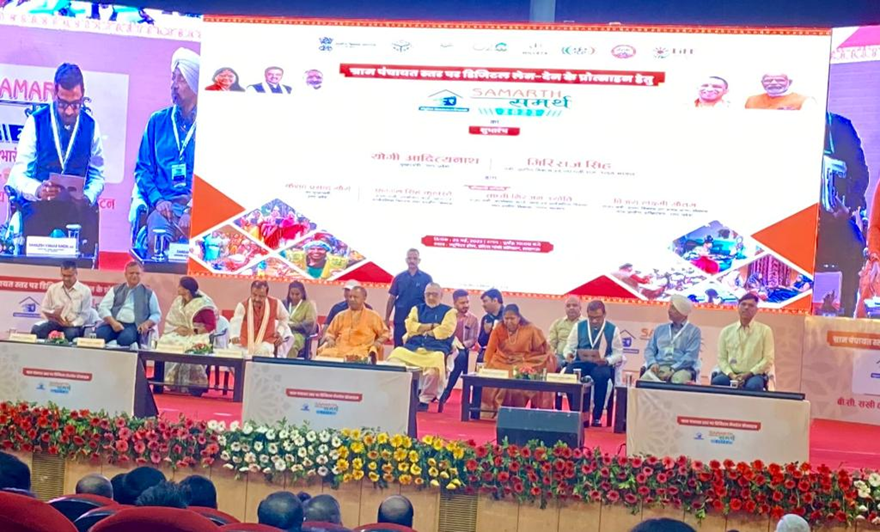Description

Copyright infringement not intended
Context: The Union Minister of Rural Development and Panchayati Raj has launched SAMARTH Campaign on Promoting Digital Transactions in 50000 Gram Panchayats under the Amrit Mahotsav in Lucknow on 25 May 2023.
Details
SAMARTH campaign
- The SAMARTH campaign, which stands for Sashakt Mahila, Aatmanirbhar Rashtra, is a joint initiative of the Ministry of Rural Development and Panchayati Raj, National Bank for Agriculture and Rural Development (NABARD), and Common Service Centres (CSCs).
- The campaign will cover all the 2.6 lakh Gram Panchayats across the country and will involve various activities such as training, workshops, competitions, and awards.
Aims
- The campaign aims to create awareness and encourage the use of digital modes of payment among the rural population, especially in the wake of the Covid-19 pandemic.
Main features of the SAMARTH campaign
- Covers 50,000-gram panchayats across the country, with a focus on aspirational districts and regions with low digital penetration.
- Targets to reach 2.5 crore rural households, including 1.25 crore women members of self-help groups (SHGs).
- Provides training and awareness on various digital payment modes such as the Aadhaar-enabled payment system (AePS), Unified Payments Interface (UPI), Bharat Interface for Money (BHIM) app, Bharat QR code, etc.
- Facilitates opening of bank accounts and linking of Aadhaar and mobile numbers for seamless transactions.
- Encourages adoption of digital transactions for various purposes such as savings, credit, remittances, social security benefits, government subsidies, etc.
- Monitors and rewards the performance of gram panchayats, SHGs, community resource persons (CRPs), bank mitras, etc. based on predefined indicators.

Significance of the SAMARTH campaign
- It contributes to the vision of Digital India and Atmanirbhar Bharat by promoting digital empowerment and financial inclusion of rural communities.
- It enhances the efficiency, transparency and accountability of public service delivery and governance at the grassroots level.
- It reduces the dependence on cash and mitigates the risks of theft, fraud and corruption.
- It improves access to formal financial services and products for the rural poor, especially women, who are often excluded or exploited by informal sources.
- It fosters a culture of savings and credit among rural households, which can help them cope with shocks and emergencies.
- It creates opportunities for income generation and livelihood enhancement through digital platforms and market linkages.
Challenges faced by the SAMARTH campaign
- The lack of adequate digital infrastructure and connectivity in remote and rural areas.
- The low levels of digital literacy and awareness among the rural population, especially women and the elderly.
- The reluctance and resistance to adopt new technologies and change existing habits and practices.
- The issues of interoperability, security and privacy of digital transactions and data.
- The coordination and convergence among multiple stakeholders involved in the campaign.
The way forward for the SAMARTH campaign
- To scale up and sustain the campaign beyond the target period and coverage by leveraging existing platforms and networks such as Common Service Centres (CSCs), Pradhan Mantri Gramin Digital Saksharta Abhiyan (PMGDISHA), etc.
- To strengthen the capacity building and handholding support for the rural communities, especially women, through bank mitras, etc.
- To enhance the quality and diversity of digital payment modes and services available for rural customers by engaging with banks and payment service providers.
- To ensure the safety and security of digital transactions and data by following best practices and standards.
- To create a conducive ecosystem for innovation and entrepreneurship in the rural digital space by facilitating access to credit, mentorship, incubation, etc.
Conclusion
- All stakeholders need to work together to make SAMARTH campaign a success and achieve the vision of a digitally literate and financially inclusive rural India.
Must Read Articles:
Digital Payments: https://www.iasgyan.in/daily-current-affairs/digital-payments
|
PRACTICE QUESTION
Q. The Government of India has recently launched the “SAMARTH Campaign”. The main objective of the Campaign is;
A) Urban Area development
B) Woman Empowerment
C) Promoting Digital Transactions
D) Skill development
Answer: C
|

https://pib.gov.in/PressReleasePage.aspx?PRID=1927237











